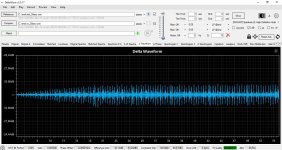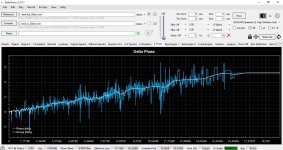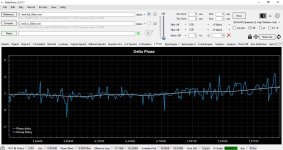I don't know what can be measured in the DAC, using the ADC on the WM8782.
Even by difference methods.
It can be used for nothing more than tube amplifiers...
I designed many different USB audio interfaces, using NXP CPU and 2 families of the XMOS CPU.
All these interfaces have external audio clock and galvanic isolation between USB and audio part.
And I have never faced with the influence of CPU clock to the audio quality.
Alex.
Even by difference methods.
It can be used for nothing more than tube amplifiers...
, just swipe xtal on XMOS
I designed many different USB audio interfaces, using NXP CPU and 2 families of the XMOS CPU.
All these interfaces have external audio clock and galvanic isolation between USB and audio part.
And I have never faced with the influence of CPU clock to the audio quality.
Alex.
I've faced with audio quality through USB just with two different motherboards. I'm tired of proving the obvious to people. To users with XMOS USB interfaces - try it, it is very simple and inexpencive. More precisely, it seems completely stupid to have to prove to skeptics and owners or creators of very good expensive devices the difference from a cheap upgrade for another peoples benefit.
Last edited:
As I said in another thread:
I don't know what can be measured in the DAC, using the ADC on the WM8782.
Even by difference methods.
It can be used for nothing more than tube amplifiers...
Alex.
I don't know what can be measured in the DAC, using the ADC on the WM8782.
Even by difference methods.
It can be used for nothing more than tube amplifiers...
Alex.
You haven't proved anything. What you have shown is misuse of DeltaWave. If you show a greater than expected difference of two short recordings how can anybody tell which is better and what is causing the difference. Only thing it proves is that either there is something wrong in your measuring setup or both recordings are bad.I'm tired of proving the obvious to people.
Should not be too difficult for you to try to prove your point:
- Make two 60s recordings of a music track you use for listening tests.
- Post both recordings and the original.
and owners or creators of very good expensive devices the difference from a cheap upgrade
The USB interface part of these devices is more or less the same.
BTW, I designed also a non expensive devices.
Alex.
Just a hint: this thread was about repair of the Q-DAC but the DAC Meisters again **** up a thread. Some are very keen pointing others at being off topic but this thread probably will again derail to the usual off topic pointless drivel. Please request a separate subsection where you can have contests who is right and who is wrong as it is NOT in the interest of readers.
Last edited:
At now it is impossible, this SMSL upgraded already and I threw out 24MHz xtal, when I get my hands on another device with XMOS I'll do it for you (next time will post with WAV file no copyrighted free music). I have these two recordings in a 1 minute duration. I cant share it because of copyright. I can compare it with original, but need to search it on Youtube (yes, I recorded this not familiar track for me, just a suggestion youtube on main page). It is just from Youtube difference, can you imagine. Both files are adjusted and fit perfectly, I can work with audio editors and familiar to Cool Edit, Sound Forge and so on from early 00 years.Should not be too difficult for you to try to prove your point:
It is simple audible thing between stereo channels in phase characteristics, I don't need to measure even 0.01 difference in THD.what can be measured in the DAC, using the ADC on the WM8782.
Last edited:
Laws of audiophilia:It is simple audible
1) Everything that can be changed - is audible.
2) It is audible when you can see what you are listening to.
3) What can't be changed doesn't affect the sound.
Alex,
If you only change the XMOS clock there should not be any need to adjust anything. And it is better to leave the matching to DeltaWave. If there is a real phase difference it should be visible no matter where the track comes from. XMOS clock allegedly causing the difference does not know anything about the track quality.Both files are adjusted and fit perfectly
I mean adjust that I cutted beginning and end to match two WAVs.any need to adjust anything
This is the analysis of 58sec files with XTAL and XO on XMOS. Looks differ than 5sec piece, enough now ? Zoomed phase graph not to look at flat line after 20KHz. Also made zoomed screen of spikes, it has different look with zoom out. But seems to me that delta phase may be caused by ADC with USB transceiver (or it may sence with original file comparing, not 2 different recordings), and we should look only at waveform delta and spectrogram delta. As for me it is enough that we have waveform delta.
Attachments
Last edited:
According to your screenshots the wav files are 192kHz 16bit. Are you sure there is no resampling occurring as Windows WASAPI shared mode does that "behind the curtains"? You should use WASAPI Exclusive mode for both DAC and ADC when recording.
As I said before your DeltaWave screenshots are useless without the original.
As I said before your DeltaWave screenshots are useless without the original.
Ok, I am back with another XMOS clock swapping. Not only is it clearly audible when replacing XMOS 24MHz XTAL with XO in SMSL, it is crealy audible when replacing cheapest noname XO with normal XO (in this expamle it is Kyocera KC3225Z12, K series will be even better). This is another DAC board with XMOS, and in these samples there are NDK 22/24MHz audio clocks, so this is only about CPU clock difference, it is so much in real so even not fully destroyed by record through crap WM ADC. The main difference is in sound stage and some amount of this (after ADC) you can hear if you put both recordings in any wave editor (easier way Audicity) and invert one track and play them together.
Already swapped two XOs and one XTAL near different XMOSes and in all cases received near the same effect.
https://limewire.com/d/XUYTU#kavOA8KeT6
Title: "Night Ambience"
Artist: Tim Kulig (timkulig.com)
Licensed under Creative Commons By Attribution 4.0
http://creativecommons.org/licenses/by/4.0/
IMDB: https://www.imdb.com/name/nm0997280/?ref_=fn_al_nm_1
Song: Night Out
Composer: LiQWYD
Website: https://www.youtube.com/channel/UCRAaeHCLbUmltner4oShkTA
License: Creative Commons (BY 3.0) https://creativecommons.org/licenses/by/3.0/
Music powered by BreakingCopyright: https://breakingcopyright.com
Already swapped two XOs and one XTAL near different XMOSes and in all cases received near the same effect.
https://limewire.com/d/XUYTU#kavOA8KeT6
Title: "Night Ambience"
Artist: Tim Kulig (timkulig.com)
Licensed under Creative Commons By Attribution 4.0
http://creativecommons.org/licenses/by/4.0/
IMDB: https://www.imdb.com/name/nm0997280/?ref_=fn_al_nm_1
Song: Night Out
Composer: LiQWYD
Website: https://www.youtube.com/channel/UCRAaeHCLbUmltner4oShkTA
License: Creative Commons (BY 3.0) https://creativecommons.org/licenses/by/3.0/
Music powered by BreakingCopyright: https://breakingcopyright.com
- Home
- Source & Line
- Digital Line Level
- Audiolab Q-DAC




